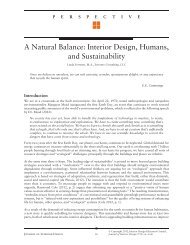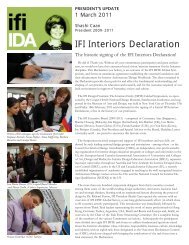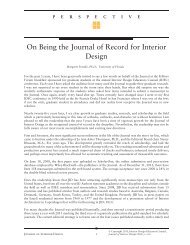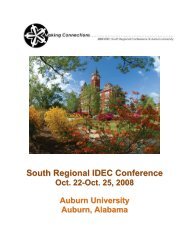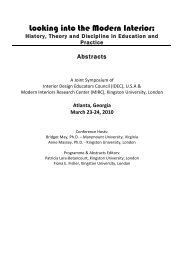2002 Conference Proceedings - Interior Design Educators Council
2002 Conference Proceedings - Interior Design Educators Council
2002 Conference Proceedings - Interior Design Educators Council
Create successful ePaper yourself
Turn your PDF publications into a flip-book with our unique Google optimized e-Paper software.
Summary of ResultsFindings indicate that Fayetteville, in its early years, was a fashion laggardarchitecturally. A comparison of mid-1800 styles (Greek Revival, Italianate) showsdelayed adoption of both styles in Fayetteville. Both styles had a small initiation towardthe end of the date range and considerable use 30 to 50 years afterward. Comparatively,plots of the Colonial Revival (1875), Queen Anne (1880), Bungalow (1890) andCraftsman (1900) styles indicate that Fayetteville adoption pattern was similar to thenation at large.Access to information about architectural style and fashion is tied directly to outerregions. The Butterfield Stage Line (1858), the University of Arkansas (1874), andrailway station construction (1881) were events that provided regular delivery of newsand an influx of people from other regions of the United States. These events coincidewith Fayetteville’s shift from laggard to mass market consumer in architectural style. InFayetteville, architectural trends were slowly adopted because of isolated locations.ReferencesArkansas Historic Preservation Program. (1999). Survey Procedure Manual. LittleRock, Arkansas.Blumenson, J. (1983). Identifying American Architecture: A Pictorial Guide to Stylesand Terms, 1600 – 1945. W.W. Norton & Company, Inc.: New York.Fayetteville, Arkansas Advertising and Promotion Commission (1999). Facts andHistory. Retrieved March 3, 2001 from the World Wide Web:http://www.fayettevillear.com/ap/.McAlester, V., & McAlester, L. (2000). A Field Guide to American Houses. Alfred A.Knopf: New York.National Register Bulletin. (1998). How to apply the National Register criteria forevaluation. U.S. Department of the <strong>Interior</strong>, National Park Service, CulturalResources, National Register, History and Education. Washington, D. C.Rifkind, C. (1980). A Field Guide to American Architecture. Plume: New York.Sproles, G. (1985). Behavioral science theories of fashion. In M. Solomon (Ed.), ThePsychology of Fashion. Lexington Books: Lexington, KY.USA Fact File. (2000). Key to the City. Retrieved March 3, 2001 from the World WideWeb: http://www.pe.net/~rksnow/arcountyfayetteville.htm#history45






